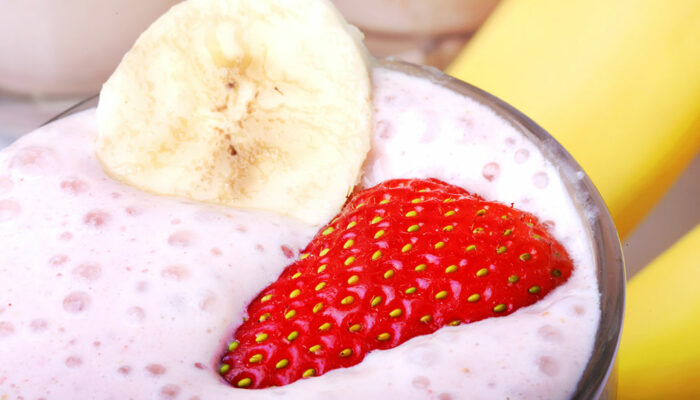8 reasons smoothies may be good for health

Smoothies are thick, creamy blends of fruits, vegetables, juices, yogurt, nuts, seeds, milk, and other ingredients. They have gained a lot of popularity over the last few years. From a delicious sweet treat to a wholesome and nourishing breakfast option, these versatile drinks can be enjoyed in several ways. This post lists eight reasons smoothies are a healthy food choice and different types of smoothies one can try making at home.
Boosts fruit and vegetable intake
Smoothies can easily pack in two to three servings of fruits and vegetables, making them an excellent way to increase their intake. Produce-loaded smoothies are a stellar source of vitamins, minerals, and antioxidants. Getting the recommended dose of fruits and vegetables per day (around five cups or 400 grams) can help reduce inflammation, aid digestion, and lower one’s risk of chronic conditions like cardiac issues, osteoporosis, and age-related cognitive decline. To prepare a simple and delicious fruit and vegetable smoothie, one can blend kale, mango, orange, and a choice of milk. Alternatively, individuals can try a nourishing cherry smoothie by blending water, spinach, cherries, milk, and banana.
Increases fiber consumption
Smoothies contain fiber-rich ingredients, such as fruits, vegetables, whole grains, probiotic-rich yogurt, kefir, nuts, seeds, and legumes. These can help prevent constipation and support healthy bacteria in the stomach. High-fiber smoothies may also help regulate digestion and promote regular bowel movements. Further, fiber intake has been associated with a reduced risk of chronic conditions like heart disease and type-2 diabetes. An avocado-pineapple smoothie with banana and chia seeds is an excellent fiber-rich smoothie. One can also prepare a high-fiber detox smoothie using milk, spinach, cooked oats, apples, raspberries, blackberries, and flaxseed.
May improve energy levels
Smoothies are a great way of boosting energy naturally since they can be full of nutrient-rich foods like bananas, berries, and greens. Using this combination for a breakfast smoothie is a simple yet healthy way of kickstarting the morning and ensuring one stays full until lunch.
Promotes hydration
Staying hydrated is crucial for good health. It helps regulate body temperature, keep the joints lubricated, prevent infections, deliver nutrients to cells, and ensure proper organ functioning. Smoothies can help people meet their daily hydration goals, as they often contain nutritious liquids, such as coconut water and fruit juices. Some recipes also contain water-rich vegetables like cucumber and celery that ensure hydration.
Can help eliminate food cravings
Smoothies are a suitable food choice when following a calorie-controlled meal plan. High-fiber smoothies with leafy greens, fruits, seeds, and added protein help promote satiety and reduce cravings for unhealthy snacks.
May enhance skin quality
Fruits and vegetables are rich in antioxidants that eliminate free radicals in the body, improving overall health. They also reduce the risk of premature aging and skin damage. Smoothies made using ingredients like berries, citrus fruits, and leafy greens can help reduce the appearance of fine lines and wrinkles and boost skin quality.
Convenient and time-saving
One of the best things about smoothies is that they are effortless to make. There’s no need to chop ingredients finely or dirty multiple dishes. All it takes is a blender, some roughly chopped fruits or vegetables, milk, water, yogurt, and ice! This helps people avoid reaching out for fast food when they are short of time to cook, which can be healthy in the long run.
Easily customizable
Another remarkable quality of smoothies is that they can be personalized to suit one’s nutritional needs and flavor preferences. Those who love sweeter beverages can make yogurt fruity smoothies by blending their favorite fruits with yogurt. Alternatively, one can add a drizzle of honey or agave to a green smoothie for a sweet flavor. Individuals can blend in a little silken tofu or cottage cheese for a protein blast. For a delicious and indulgent dessert, blend ice cream with fruits or other toppings of choice! It is also possible to adjust the smoothie’s texture to one’s liking; add more frozen fruit or ice for thicker smoothies and a little more liquid for thinner smoothies.
A smoothie’s health benefits depend on the quality and quantity of ingredients used. Individuals must exercise caution when buying a smoothie since it may contain added sugars. This reduces its nutritional value and increases the risk of chronic conditions like heart disease, type 2 diabetes, and liver disease. Instead of adding sweetening agents like sugar, honey, maple syrup, ice cream, sherbet, and agave nectar to smoothies, one must use naturally sweet fruits like ripe bananas, peaches, apples, mangoes, or strawberries. When buying bottled smoothies, individuals must check the label carefully for added sugar content or inquire about the product’s nutritional information at the counter.
Types of smoothies
Based on the ingredients used, smoothies are mainly categorized into three different types as follows:
Fruit smoothies
These are generally made by blending one or more fruits with fruit juice, water, milk, or ice cream.
Green smoothies
These are packed with fresh green vegetables like spinach and kale. Some may also include a little fruit for a dash of sweetness.
Protein smoothies
Protein smoothies have protein-rich ingredients like Greek yogurt, cottage cheese, silken tofu, and protein powder. These are great for promoting post-workout recovery, as they help replenish glycogen stores and repair torn muscles.
A smoothie is among the best breakfast or snack options. It is delicious, easy to make, and rich in nutrients. However, one must try to use fruits and vegetables in their recipes as far as possible. Doing so will maximize health benefits, keep sugar content low, and avoid glycemic spikes. It is also essential to be mindful of the quantity and quality of ingredients added and avoid excess sugar when preparing smoothies at home.





